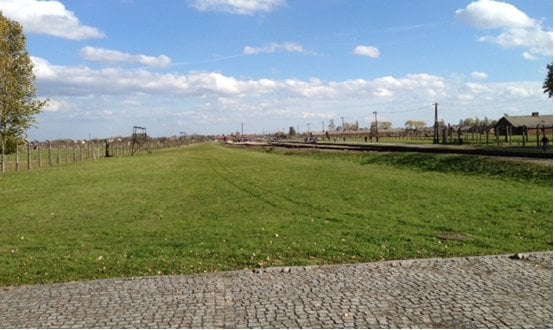Joe’s view: of openness
- 12 November 2012

We went to Poland earlier this month (Jet2 direct from Newcastle £50 each return). We had a great weekend of hazelnut vodka and dumplings; but on the last day we felt we should visit the nearby concentration camps.
It was an incongruously beautiful, sunny day and as we walked around the Birkenau death camp it was hard to conjure up the true horror of the place.
I didn’t really feel it until I came out through the main entrance and looked back down the single train track that led through the gates to the accommodation for the workers. And, beyond that, the gas chambers.
What struck me was the nature of the buildings. They were ordinary in the extreme; drab, low-rise brick buildings. Looking down the track, it could have been any British branch line station.
Walking around Birkenau’s older sister, Auschwitz, I was struck by its similarity to many of the older mental health hospitals I trained in; its only flourish was the mocking Arbeit Macht Frei sign over the gate.
I had come expecting a more obviously evil architecture; like something from a Frankenstein film by Hammer Horror Films. Still, I took only one photograph because I didn’t really want it on my phone.
Speaking out
Our guide, Bob the Polish Taxi Driver, told us about the people who had resisted and attempted to let the world know what was going on in this previously beautiful corner of rural Poland.
He said that the allies knew as early as 1941 what was going on, but could not believe it. Sadly, for most it was impossible to speak out because of the culture of fear which existed.
We returned from Poland to the Jimmy Savile revelations. Hundreds of allegations from victims of sexual abuse appear to have washed over the BBC.
His victims appear to have been carefully chosen to make sure they would not be believed if they spoke out. And the culture of the time may have made it difficult, if not impossible, for almost anybody to speak out about sexual abuse by a high profile celebrity in any event.
This prompted me to muse on whether there is something in the human condition which prevents people from speaking out.
Why it’s so hard
The answer is yes. We are descended from the apes, we live in social groups with often quite strict pecking orders, and if those at the top choose to abuse their position the culture of the group can quickly become oppressive.
The fear of being isolated from or shunned by the group was hard-wired into our hind-brain, our primeval unconscious a million years ago.
We forget this at our peril. The ascent of man is largely the history of the wider group learning to moderate/control the behaviour of its leaders- hence democracy.
But democracy has its own risk. Because the power of the government minister is legitimately acquired there is even less likelihood that civil servants will say: “Well, actually Prime Minister that’s a particularly ill thought out idea on which to spend £12.7 billion that we haven’t got.”
Stanley Milgram’s classic obedience to authority experiments showed that many of us could be death camp guards if we were dropped into a powerfully authoritarian culture.
Perfectly decent people can be persuaded to do the wrong thing if the culture is wrong. Consequently, you have to make arrangements to make sure that followers can disagree with the leadership and be heard.
The culture of an organisation has to be actively monitored. And history has to be studied. In 1957, the Cabinet Secretary, Sir Norman Brook, urged all government departments to write historical accounts of key policy decisions.
He declared: ‘We make many forecasts but few retrospects. More post-mortems would be salutary.’
Good news
Well, in an encouraging development Sir Norman would doubtless approve of, the DH Informatics Directorate Clinical Division have kindly invited me to attend a lessons learned event next month to see what can be culled from the experience of the National Programme for IT in the NHS.
Unfortunately, because of my clinical commitments, I won’t be able to attend; so this column will have to be my contribution.
Lots of my excellent (though frustrated) former and still serving colleagues within NHS Connecting for Health will be able to talk about: Tony [Blair]’s political vanity project; contracts signed in undue haste; the domination of a clinical project by techies; the absence of clinical leadership at the outset; the madness of at-scale, untried innovation; a failure to standardise clinically; the technical IT challenges; usability; and the information governance nightmare.
So I’ll leave that to them. As a psychiatrist and analyst of human systems, the key insight I have gleaned from my recent trip to Poland, and the unfolding Jimmy Savile scandal, and my experience of NPfIT is the power of culture.
There has been excellent work within safety-critical industries – most obviously the airline industry – that has been translated into patient safety (my area of specialist interest – IT was only ever a means to and end).
Ron Westrum, working initially in the oil industry, described three levels of maturity for organisations with regard to their attitude to safety:
Pathological
Where typically
- Information is hidden
- Messengers are “shot”
- Responsibilities are shirked
- Bridging is discouraged (going outside your line management if sufficiently worried)
- Failure is covered up
- New ideas are actively crushed.
Bureaucratic
Where typically
- Information may be ignored
- Messengers are tolerated
- Responsibility is compartmentalised
- Bridging is allowed but neglected
- Organisation is just and merciful
- New ideas create problems.
Generative
Where typically
- Information is actively sought
- Messengers are trained
- Responsibilities are shared
- Bridging is rewarded
- Failure causes inquiry
- New ideas are welcomed.
Building on Westrum’s idea that organisations have a personality, these ideas have been usefully incorporated into a workshop approach called the Manchester Patient Safety Assessment Framework or MaPSAF.
Anybody can run this in any healthcare organisation to make an assessment of the culture of that organisation.
It requires some courage and a willingness to embrace bad news; but ultimately allows an organisation to make an assessment of its own culture and make plans to improve it.
Meet the new boss?
As CfH transitions to its new homes, there is a natural desire to minimise redundancies.
This means that many of the “new” jobs created in the DH, the NHS Commissioning Board and the ‘new’ Health and Social Care Information Centre will only be open to familiar faces.
Sadly, this means there is a real risk that the bureaucratic and, at worst, pathological CfH culture will transfer with them.
Maybe this is why government repeatedly fails to get big IT projects right. Visible leaders fall or get pushed onto their swords; and troublesome, complaining end-users are expendable.
But the middle layer of the government machine always transitions itself into new arrangements and survives.
In doing so, it does not necessarily learn anything other than the art of survival and that elected officials are mere temporary staff. The organisational memory is deleted, allowing failure to be repeated.
Always look on the bright side
Refreshingly, Tim Kelsey, the new national director of patients and information at the NHS CB, is not a traditional DH apparatchik.
He also preaches a strategy of openness, which is very welcome. But the old saying “culture eats strategy for breakfast” keeps coming to mind.
I already detect that the “machine” regards him as a dangerous interloper who wants to rock an otherwise cosy boat, crewed by old pals. We shall see.
I applaud the attempt to learn lessons but I would urge the new homes for CfH to undertake MaPSAF or similar as part of their organisational development process.
Bob, the Polish Taxi Driver is something of a character but as an end user of his service I thoroughly recommend him if you are visiting Kracow .
Bob only knows one psychiatry joke, which he told us on the way from Auschwitz to the airport by way of lightening the understandably dark mood.
“How many psychiatrists does it take to change a light bulb?”
“Only one, but the light bulb really has to want to change.”




